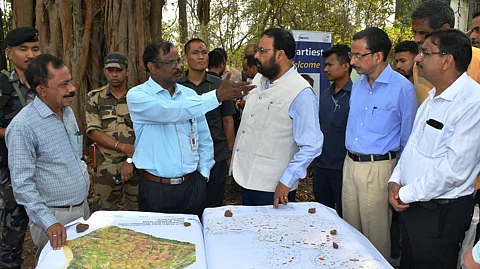
- Home
- Live Blog
- Breaking News
- Top Headlines
- Cities
- NE News
- Sentinel Media
- Sports
- Education
- Jobs

Staff Reporter
GUWAHATI: Indian Space Research Organisation (ISRO) chairman Dr V. Narayanan and his team today visited the site for the setting up of a state-of-the-art space surveillance project called Network of Space Object Tracking and Analysis (NETRA) centre at Chandrapur on the outskirts of Guwahati.
It is the first of its kind in the country. The state government is ready to provide all logistical support for this centre.
Speaking to the media after the inspection of the site, ISRO chairman said that a highly powerful and advanced radar system would be established at the NETRA project site within this year. “This radar will be capable of continuously monitoring a range of up to 2000 km in space and accurately detecting objects as small as ten centimetres. It may take four years to complete the entire project. Through the NETRA centre, continuous surveillance of satellites and space debris, as well as any space-borne threats, will be carried out,” he said.
Assam Science and Technology Minister Keshab Mahanta, who accompanied the team of scientists visiting the site, said, “The land of the site originally belonging to the ASEB has already been transferred to the Revenue Department. The process for the state government to hand over this plot of land to ISRO is almost final. However, we have requested ISRO to go ahead with the project. ISRO visited many probable sites for the project, and they have finally chosen the site, Chandrapur.”
On AsamSat, the dream project of Chief Minister Dr Himanta Biswa Sarma to have a satellite of the state, Mahanta said, “We talked to the ISRO scientists on the very first day of the financial year about AssamSat, a proposal made in the state budget 2025-26. We’re going to prepare an action plan in accordance with advice received from the ISRO scientists. I hope, with NETRA and AssamSat, the state will be a few steps ahead of other states of the country on space technology.”
The highlights of the setting up of the NETRA centre, according to the Department of Science and Technology, Assam, will be (i) building observational capabilities to track space objects through a network of in-house tracking facilities; (ii) establishing a centralised mechanism for processing observations, cataloguing, assessment of space situations, and timely dissemination of SSA information to safeguard national space assets; and (iii) the Phased Array Radar at Chandrapur, Assam, is capable of detecting 10 cm space objects at ranges up to 2000 km. It is designed and built indigenously and operated through ISTRAC (ISRO Telemetry Tracking and Command Network), realising the dream of Assam and the Northeast to have an ISRO Centre.
The NETRA centre is going to have provisions to allow students from the region to have opportunities for internships, training, skill development, etc.
Also Read: Assam’s Own Satellite: ISRO Chief Assures all Assistance
Also Watch: